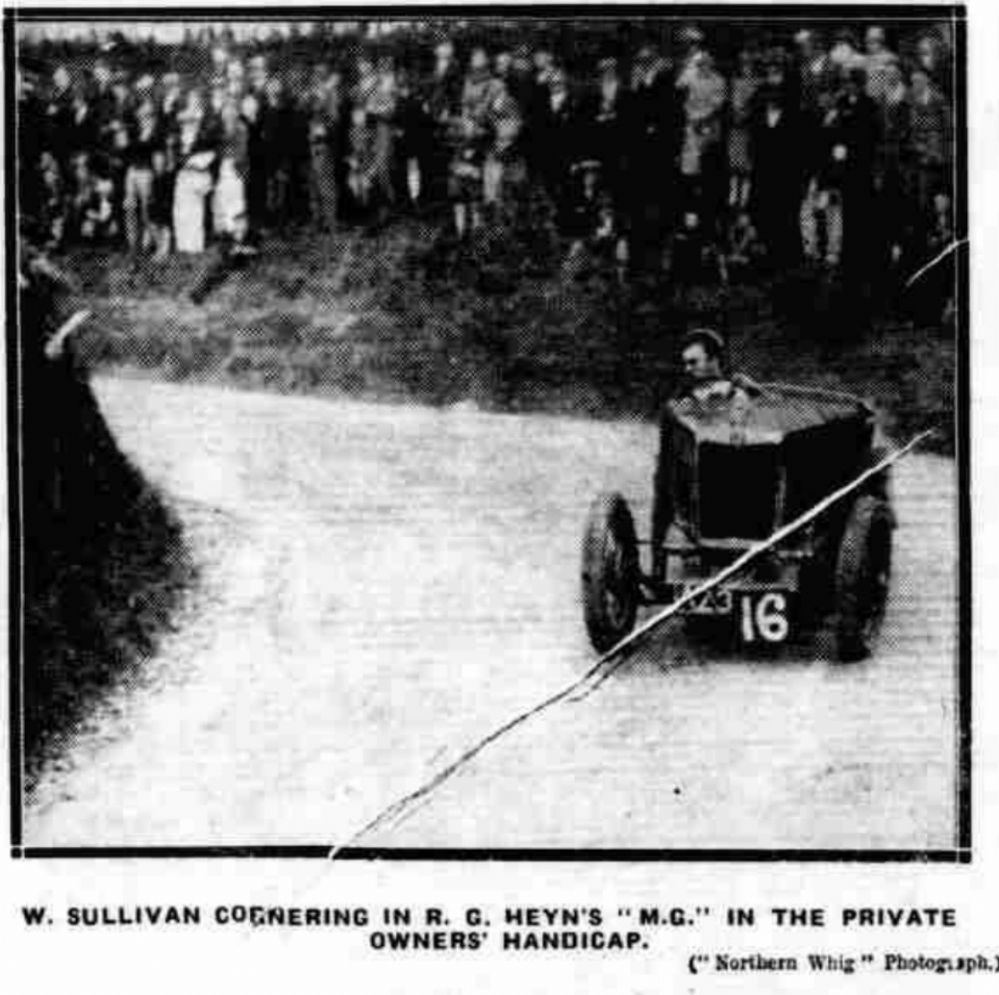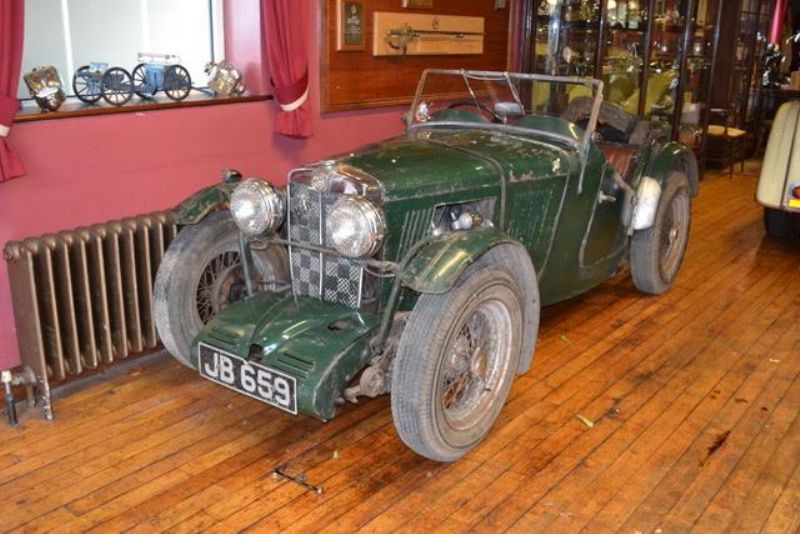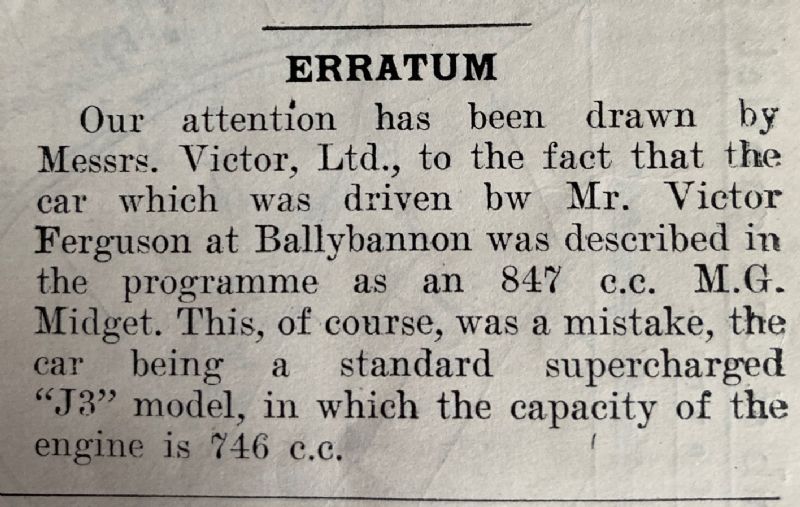| Author |
 Topic Topic  |
|
Simon Johnston
United Kingdom
6637 Posts |
 Posted - 19/10/2020 : 06:39:15 Posted - 19/10/2020 : 06:39:15

|
I thought this topic would have been locked, but clearly not, so Iím adding this photo just to close out the query on page 2 of the thread about who was driving the M Type at Craigantlet.
As the photo below shows, the car was entered by R.G. Heyn and driven by Billy Sullivan but the date of the newspaper from which to comes is 1929, not 1932 as was suggested above.

Simon J
J3437
Simon
I have deleted that reply and moved it to General Information 19OCT2020.
Nick |
 |
|
|
Blue M
United Kingdom
1493 Posts |
 Posted - 19/10/2020 : 07:23:08 Posted - 19/10/2020 : 07:23:08

|
| Simon, is this the same Billy Sullivan that built and raced in the TT special Morris Minors a couple of years later? |
 |
|
|
Simon Johnston
United Kingdom
6637 Posts |
 Posted - 19/10/2020 : 08:44:04 Posted - 19/10/2020 : 08:44:04

|
Indeed it is, Ian. Thereís an interesting tale to tell about Billy but itís proving slow going to get much information about him.
Simon J
J3437 |
 |
|
|
Mike Allison
United Kingdom
196 Posts |
 Posted - 19/10/2020 : 16:07:46 Posted - 19/10/2020 : 16:07:46

|
| Surely 084XI is a trade plate number? I am not familiar with the Ulster series, but the plate looks similar to those used here on the mainland, where they are usually red, rather than black. |
 |
|
|
Simon Johnston
United Kingdom
6637 Posts |
 Posted - 19/10/2020 : 16:44:34 Posted - 19/10/2020 : 16:44:34

|
Yes, Mike, itís a trade plate. This was established right at the outset of this topic. The plates on the Ferguson car have white numbers on a red background and so were General plates that could be used for just about any purpose. The other type of trade plate in those days were Limited plates which were red numbers on a white background. They were much more restricted in use (and cost a lot less than General plates) and when using them the driver had to carry a form stating the reason for the journey, estimated starting and finishing times, the driver's name and the driver had to be an employee of the firm that owned the plate.
Simon J
J3437 |
 |
|
|
Mike the M
United Kingdom
486 Posts |
 Posted - 02/11/2020 : 20:31:09 Posted - 02/11/2020 : 20:31:09

|
Who was R. G. Heyn, I cannot find him on Ancestry!!
Mike Dalby |
 |
|
|
Simon Johnston
United Kingdom
6637 Posts |
 Posted - 02/11/2020 : 21:16:59 Posted - 02/11/2020 : 21:16:59

|
A local Norn Iron motoring enthusiast.
Simon J
J3437 |
 |
|
|
Simon Johnston
United Kingdom
6637 Posts |
 Posted - 09/12/2023 : 10:19:11 Posted - 09/12/2023 : 10:19:11

|
I had expected that this ten-year old thread would have been locked but since it isnít Iím adding to it to report that J2024/JB 659 has finally surfaced again and is in good hands here in Norn Iron.

The factory records show that the car was always referred to internally as a J3, despite having a J2 chassis number, and it was not returned to J2 spec by the factory as suggested above but was sold as a J3 in January 1934 to its first owner.
A truly important car and we can expect to see it back on the road, hopefully to full J3 spec, in the not too distant future.
Simon J
J3437 |
 |
|
|
colintf
United Kingdom
1550 Posts |
|
|
Nick Feakes
USA
3621 Posts |
 Posted - 09/12/2023 : 22:09:21 Posted - 09/12/2023 : 22:09:21

|
Simon
These threads do not become locked as I do not archive this forum for the very reason that is evident above. New information comes to light about a picture of a car or of an event years after the original topic was created and adds to the sum of all knowledge. I for one, thoroughly enjoy reading these voyages of discovery.
Nick
Webmaster |
 |
|
|
Simon Johnston
United Kingdom
6637 Posts |
 Posted - 09/12/2023 : 23:04:53 Posted - 09/12/2023 : 23:04:53

|
Thanks, Nick. That seems to be very sensible. 
Simon J
J3437 |
 |
|
|
Ralph
United Kingdom
73 Posts |
 Posted - 19/12/2023 : 09:26:47 Posted - 19/12/2023 : 09:26:47

|
| Isnít that JB659 (the prototype J3 ) |
 |
|
|
Simon Johnston
United Kingdom
6637 Posts |
 Posted - 19/12/2023 : 10:07:38 Posted - 19/12/2023 : 10:07:38

|
Er, yes, thatís what I said - J2024/ JB 659 - and what the photo shows!
Simon J
J3437 |
 |
|
|
KevinA
New Zealand
723 Posts |
 Posted - 26/08/2024 : 01:08:08 Posted - 26/08/2024 : 01:08:08

|
Perhaps this new book might be of interest- text shamelessly stolen from https://www.prewarcar.com/review-two-new-titles-shedding-fresh-light-on-irish-motor-sport-history
From Ballybannon Hill to Magilligan Strand: Hill Climbs, Sand Races and a Cancelled Grand Prix, June 1922 to June 1933
Author: Paul Robinson
Publisher: Paul Robinson. www.robinsonbooks.co.uk
Price: £30.00. 304 pages with dozens of black-and-white photographs
For his second work, Robinson's research yielded a lot more information, as would be expected given its broader scope; From Ballybannon Hill to Magilligan Strand is a substantial 300 pages and looks chronologically at the major hill-climbs and sand-racing events up to 1933, namely Ballybannon, Craigantlet, Croft, Red Brae ("no freak cars permitted") and Magilligan Strand. The cancelled Grand Prix referred to in the title was the 1924 Ulster Motor Grand Prix at Clady, the established home of the Ulster Motorcycle Grand Prix, which was called off following Stanley Pyper's fatal accident in an Alvis during an "unofficial practice."
As mentioned above, a few early, pre-Great War hill-climbs are outlined in brief. These show that Ballybannon was a major event in 1903, when participants included S. F. Edge with a 40hp Napier, Herbert Austin with a 50hp Wolseley, C. S. Rolls with an 80hp Mors and, most notably, the 100hp Gobron-Brilliť of Louis Rigolly, who would become the first man ever to exceed 100mph in 1904. These race meetings, of course, were only able to become regular occurrences once motor-racing on public roads was officially authorised in 1922, with the creation of Northern Ireland, and the rest of the book runs from there to the final Ballybannon meeting in 1933. With the exception of inventor, tractor-maker and front-wheel drive pioneer Harry Ferguson, who was a vocal advocate for the advancement of automobilism in Ireland, these later Ballybannon meetings were comprised largely of privateers whose names have not made the history books, but the revived Craigantlet Hill-Climb of 1925, which remains in use today, was of sufficient importance by the early '30s that it attracted the likes of Earl Howe, Dudley Benjafield, Tommy and Elsie Wisdom and Cecil Kimber. The book does not just consist of reports of race meetings; where applicable, Robinson has also provided context by examining changing legislation and the rŰle of the short-lived Ulster Automobile Club.
Some of the photographs used illustrate just what a wonderful variety of machines participated in the various events. At the June, 1928, Magilligan Speed Trials, for example, the square and upright frame of W. Noble's Morris Cowley coupť makes for quite the contrast with G. C. Strachan's little torpedo of an Amilcar. The same event yielded the charismatic cover picture, of W. H. Connolly flashing a mischievous grin from within his racing Star. A few of the photos really capture the excitement, and occasional horror, of those brave days. One depicts the Rhode of Charles Wilkinson flying sideways through the air at the Magilligan races of 1926. Remarkably, when the car landed, Wilkinson emerged with only minor injuries, but Charles N. Norris was not so fortunate; he appeared as the headline driver "with two Brooklands successes," but died that day when his works-prepared 1Ĺ-litre Lea-Francis was involved in a similar accident. We also see the aftermath of R. G. J. Nash's hair-raiser at Craigantlet in 1932. Driving his famous Frazer-Nash, The Terror, he shot up a bank and stopped perilously short of the rows of spectators.
Once again, much of the book is made up of reprinted entry lists, results and newspaper reports, and the R.I.A.C. Archive and British Newspaper Archive have supplied many of the photos, but Robinson has done a sterling job of tracking down unseen photographs held by the families of the drivers who raced in the period, and a dedicated motor sport enthusiast might find it worth investing in the book for these alone.
The appeal of both works is admittedly niche, but it must go without saying that anyone with a particular interest in Irish motor sport history shouldn't be without them. Furthermore, anyone planning a visit to Northern Ireland ought to find them fascinating holiday reading, and useful, perhaps, for the purpose of pre-war motor sport tourism. As reference works they are extremely valuable; the information contained within is not easily accessible by any other means and they are in no way unreasonably priced. Robinson has done us a great service by making this information available, and readers will do well to look out for his next book, about the County Down Trophy Races of 1934-36, which is due for release in November.
|
Edited by - KevinA on 26/08/2024 01:09:00 |
 |
|
|
Simon Johnston
United Kingdom
6637 Posts |
 Posted - 26/08/2024 : 07:03:54 Posted - 26/08/2024 : 07:03:54

|
Indeed, an excellent and most useful book. Paul is a good friend of mine and in this book he solves one of the mysteries about JB 659. It was entered in Ballybannon as 847cc supercharged but as 746cc supercharged at Craigantlet a few months later. There was speculation that M.G. might have been experimenting with an 847cc supercharged engine but the facts, as uncovered by Paul, were more prosaic as he found this in the July 1933 issue of the Ulster Automobile Club's Monthly Review:

Problem solved - a simple clerical error.
Update: the car has changed hands again. Jim Black decided that he would concentrate his efforts on a recently acquired Speed Six Bentley and the car is now with another local enthusiast. Progress is good: the J engine that came along with the car is being rebuilt to J3 spec with an Arnott supercharger; the body is being carefully refurbished; and the chassis has been stripped to start the process of restoring and rebuilding it. Itís in good hands.
Simon J
J3437 |
Edited by - Simon Johnston on 26/08/2024 07:13:51 |
 |
|
 Topic Topic  |
|

